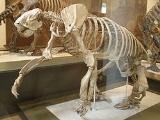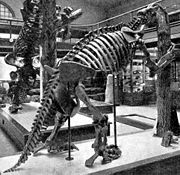
Megalonyx
Encyclopedia
Megalonyx is an extinct genus
of giant ground sloths of the family Megalonychidae
endemic to North America
from the Hemphillian
of the Late Miocene
through to the Rancholabrean
of the Pleistocene
, living from ~10.3 Mya—11,000 years ago, existing for approximately .
in 1797, based on fossil specimens of what later came to be called Megalonyx jeffersonii
that he had received from western Virginia
. His presentation to the American Philosophical Society
that year is often credited as the beginning of vertebrate paleontology
in North America
. However, Jefferson's name has no validity in zoological nomenclature, and Megalonyx was first formally named by Richard Harlan
in 1825.
from South America
, where ground sloths arose, prior to formation of the Panamanian land bridge
. Its appearance in North America thus predates the bulk of the faunal exchange
between North and South America. Its immediate predecessor was Pliometanastes
and its closest living relatives are the two-toed sloth
s (Choloepus).
and the Yukon
.
may reveal something of the familial life of Megalonyx. An adult was found in direct association with two juveniles of different ages, suggesting that adults cared for young of different generations.

(incomplete listing)
. American Philosophical Society, 12:73-102. (1893) A preliminary report on the vertebrate paleontology of the Llano Estacado. 4th Annual Report on the Geological Survey of Texas: 136pp. (1968) Plio-Pleistocene megalonychid sloths of North America. Bulletin of the Florida State Museum Biological Sciences, 12(5):213-296.
Genus
In biology, a genus is a low-level taxonomic rank used in the biological classification of living and fossil organisms, which is an example of definition by genus and differentia...
of giant ground sloths of the family Megalonychidae
Megalonychidae
Megalonychidae is a group of sloths including the extinct Megalonyx and the living two toed sloths. Megalonychids first appeared in the early Oligocene, about 35 million years ago, in southern Argentina , and spread as far as the Antilles by the early Miocene...
endemic to North America
North America
North America is a continent wholly within the Northern Hemisphere and almost wholly within the Western Hemisphere. It is also considered a northern subcontinent of the Americas...
from the Hemphillian
Hemphillian
The Hemphillian North American Stage on the geologic timescale is the North American faunal stage according to the North American Land Mammal Ages chronology , typically set from 10,300,000 to 4,900,000 years BP, a period of . It is usually considered to overlap the Tortonian epoch of the Late...
of the Late Miocene
Late Miocene
The Late Miocene is a sub-epoch of the Miocene Epoch made up of two stages. The Tortonian and Messinian stages comprise the Late Miocene sub-epoch....
through to the Rancholabrean
Rancholabrean
The Rancholabrean North American Stage on the geologic timescale is the North American faunal stage according to the North American Land Mammal Ages chronology , typically set from less than 240,000 years to 11,000 years BP, a period of . It is usually considered to overlap the Middle Pleistocene...
of the Pleistocene
Pleistocene
The Pleistocene is the epoch from 2,588,000 to 11,700 years BP that spans the world's recent period of repeated glaciations. The name pleistocene is derived from the Greek and ....
, living from ~10.3 Mya—11,000 years ago, existing for approximately .
Taxonomy
The generic name Megalonyx was proposed by future U.S. President Thomas JeffersonThomas Jefferson
Thomas Jefferson was the principal author of the United States Declaration of Independence and the Statute of Virginia for Religious Freedom , the third President of the United States and founder of the University of Virginia...
in 1797, based on fossil specimens of what later came to be called Megalonyx jeffersonii
Megalonyx jeffersonii
Megalonyx jeffersonii, or Jefferson's ground sloth, is an extinct species of giant ground sloth that lived from the Illinoian Stage during the Middle Pleistocene through to the Rancholabrean of the Late Pleistocene . Its closest living relatives are the two-toed tree sloths of the genus...
that he had received from western Virginia
Virginia
The Commonwealth of Virginia , is a U.S. state on the Atlantic Coast of the Southern United States. Virginia is nicknamed the "Old Dominion" and sometimes the "Mother of Presidents" after the eight U.S. presidents born there...
. His presentation to the American Philosophical Society
American Philosophical Society
The American Philosophical Society, founded in 1743, and located in Philadelphia, Pa., is an eminent scholarly organization of international reputation, that promotes useful knowledge in the sciences and humanities through excellence in scholarly research, professional meetings, publications,...
that year is often credited as the beginning of vertebrate paleontology
Vertebrate paleontology
Vertebrate paleontology is a large subfield to paleontology seeking to discover the behavior, reproduction and appearance of extinct animals with vertebrae or a notochord, through the study of their fossilized remains...
in North America
North America
North America is a continent wholly within the Northern Hemisphere and almost wholly within the Western Hemisphere. It is also considered a northern subcontinent of the Americas...
. However, Jefferson's name has no validity in zoological nomenclature, and Megalonyx was first formally named by Richard Harlan
Richard Harlan
Richard Harlan was an American naturalist, zoologist, physicist and paleontologist....
in 1825.
Biogeography and phylogeny
Megalonyx evolved from ancestors that island-hopped across the Central American SeawayCentral American Seaway
The Central American Seaway, also called the Panamanic Seaway or Inter-American Seaway was an ancient body of water that once separated North America from South America...
from South America
South America
South America is a continent situated in the Western Hemisphere, mostly in the Southern Hemisphere, with a relatively small portion in the Northern Hemisphere. The continent is also considered a subcontinent of the Americas. It is bordered on the west by the Pacific Ocean and on the north and east...
, where ground sloths arose, prior to formation of the Panamanian land bridge
Isthmus of Panama
The Isthmus of Panama, also historically known as the Isthmus of Darien, is the narrow strip of land that lies between the Caribbean Sea and the Pacific Ocean, linking North and South America. It contains the country of Panama and the Panama Canal...
. Its appearance in North America thus predates the bulk of the faunal exchange
Great American Interchange
The Great American Interchange was an important paleozoogeographic event in which land and freshwater fauna migrated from North America via Central America to South America and vice versa, as the volcanic Isthmus of Panama rose up from the sea floor and bridged the formerly separated continents...
between North and South America. Its immediate predecessor was Pliometanastes
Pliometanastes
Pliometanastes is an extinct genus of giant ground sloths of the family Megalonychidae endemic to North America during the Miocene epoch through very early Pliocene epoch. Its fossils have been found across the southern U. S. from California to Florida....
and its closest living relatives are the two-toed sloth
Two-toed sloth
Choloepus is a genus of mammals of Central and South America, within the family Megalonychidae consisting of two-toed sloths. There are only two species of Choloepus : Linnaeus's Two-toed Sloth and Hoffmann's Two-toed Sloth...
s (Choloepus).
Range
Megalonyx ranged over much of North and Central America. Their remains have been found as far north as AlaskaAlaska
Alaska is the largest state in the United States by area. It is situated in the northwest extremity of the North American continent, with Canada to the east, the Arctic Ocean to the north, and the Pacific Ocean to the west and south, with Russia further west across the Bering Strait...
and the Yukon
Yukon
Yukon is the westernmost and smallest of Canada's three federal territories. It was named after the Yukon River. The word Yukon means "Great River" in Gwich’in....
.
Parental care
Ongoing excavations at Tarkio Valley in southwest IowaIowa
Iowa is a state located in the Midwestern United States, an area often referred to as the "American Heartland". It derives its name from the Ioway people, one of the many American Indian tribes that occupied the state at the time of European exploration. Iowa was a part of the French colony of New...
may reveal something of the familial life of Megalonyx. An adult was found in direct association with two juveniles of different ages, suggesting that adults cared for young of different generations.
M. leptostomus
M. leptostomus was named by Cope (1893). This species lived from Florida to Texas, north to Kansas and Nebraska, and west to New Mexico, Nevada, Oregon, and Washington.Fossil distribution

- Taunton site, Adams County, Washington. est. age ~3.4—3.3 Mya.
- Wild Horse Butte aka UO 2396, Owyhee County, IdahoOwyhee County, IdahoOwyhee County is a county located in the southwestern corner of the U.S. state of Idaho. In area it is the second largest county in Idaho, behind Idaho County. As of the 2000 Census, Owyhee County had a population of 10,644...
. est. age ~2.7—2.1 Mya. - Buckeye Creek (UCMP V-93067), Douglas County, NevadaDouglas County, NevadaDouglas County is a county located in the northwestern part of the U.S. state of Nevada. As of 2000, the population was 41,259. As of 2010, the population was estimated to be 46,997.- History :...
. est. age ~4.4—4.5 Mya. - Kuchta Sand Pit, Yankton County, South DakotaYankton County, South DakotaYankton County is a county located in the U.S. state of South Dakota. As of the 2010 census, the population was 22,438. It's county seat is Yankton.Yankton County is the only county in the Yankton Micropolitan Statistical Area.-Geography:...
est. age ~2.9—2.1 Mya. - Meade's Quarries 4 and 5, Crosby County, Texas est. age ~3.7—1.5 Mya.
- Haile 7CHaile Quarry siteThe Haile Quarry or Haile sites are an Early Miocene and Pleistocene assemblage of vertebrate fossils located in the Haile quarries, Alachua County, northern Florida. The assemblage was discovered during phosphate mining, which began in the late 1940s. Haile sites are found in the Alachua Formation...
, Alachua County, FloridaAlachua County, FloridaAlachua County is a county located in the U.S. state of Florida. The U.S. Census Bureau 2006 estimate for the county is 227,120. Its county seat is Gainesville, Florida. Alachua County is the home of the University of Florida and is also known for its diverse culture, local music, and artisans...
. ~1.6—1.5 Mya. - Kissimmee River, Okeechobee County, FloridaOkeechobee County, FloridaOkeechobee County is a county located in the state of Florida. As of 2000, the population was 35,910. According to 2005 U.S. Census estimates, its population had grown to 39,836. The county seat is Okeechobee, Florida. The county comprises the Okeechobee, Florida Micropolitan Statistical Area.-...
est. age ~2.3 Mya.
(incomplete listing)
Other sources
(1871) Preliminary report on the vertebrata discovered in the Port Kennedy Bone CavePort Kennedy Bone Cave
The Port Kennedy Bone Cave is a limestone cave in Port Kennedy, Pennsylvania, USA. The Bone Cave "contained one of the most important middle Pleistocene fossil deposits in North America"....
. American Philosophical Society, 12:73-102. (1893) A preliminary report on the vertebrate paleontology of the Llano Estacado. 4th Annual Report on the Geological Survey of Texas: 136pp. (1968) Plio-Pleistocene megalonychid sloths of North America. Bulletin of the Florida State Museum Biological Sciences, 12(5):213-296.

